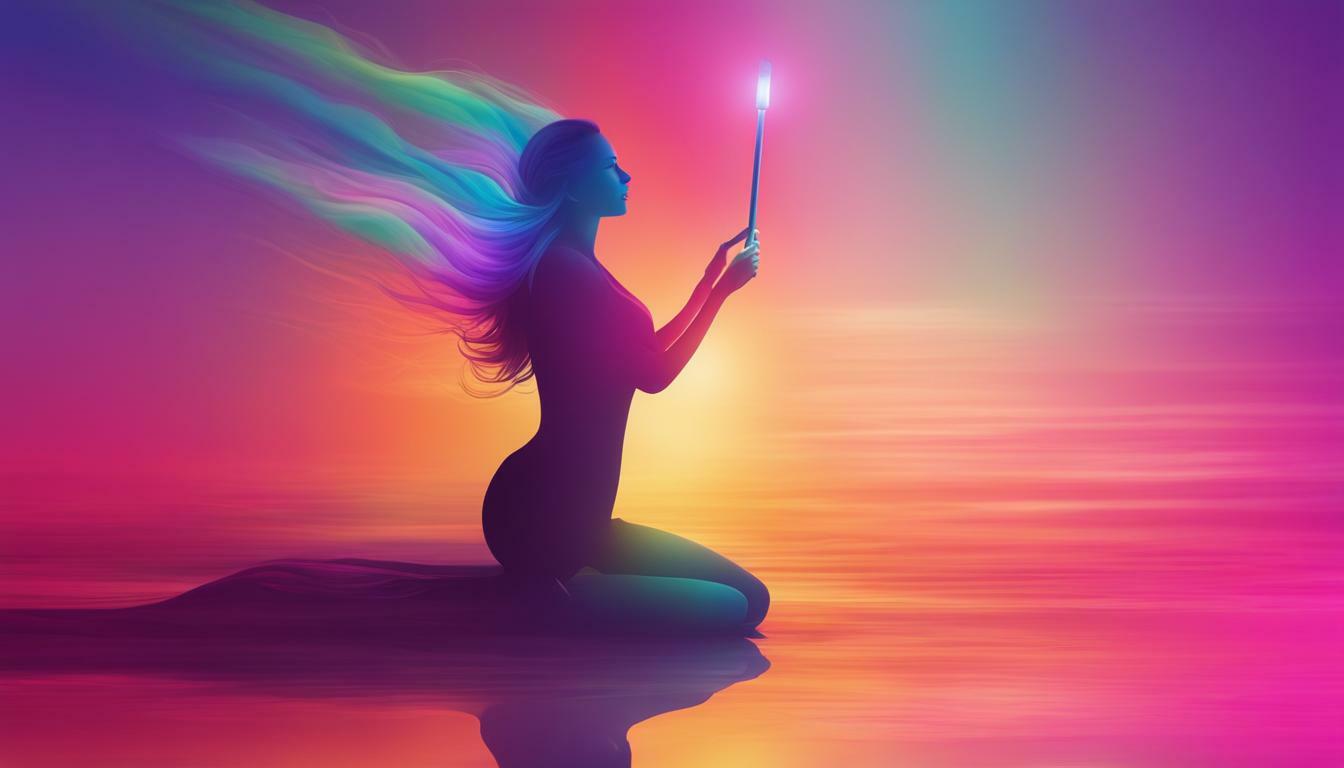Anger can be a challenging emotion to navigate, but with color therapy, you can learn to manage it effectively. While anger is a normal part of the human experience, it can become problematic when it spirals out of control. Instead of suppressing anger, the key to anger management is finding healthier ways to express and channel it. Color therapy offers a natural and easy method to control anger by harnessing the power of different colors.
- Color therapy can be used to effectively manage anger.
- Anger management involves expressing anger in a more rational way, rather than suppressing it.
- Different colors have different effects on the body and mind, such as energizing, relieving stress, improving mood, and stimulating mental activity.
- Color therapy is considered alternative medicine and has not been scientifically proven to be effective for medical conditions.
- Incorporating mindful color choices and eliminating blue lights at night can support anger management.
Understanding Color Therapy for Anger Management
Color therapy, also known as chromotherapy, is a practice that utilizes different colors to influence our emotional and mental well-being. Anger is a normal emotion that everyone experiences, but it can become problematic when it becomes uncontrollable. Managing anger is not about suppressing it, but rather finding healthier ways to express and control it. Color therapy offers a natural and easy way to manage anger by harnessing the power of different colors.
By understanding the therapeutic use of colors for anger management, we can tap into their psychological effects and utilize them to our advantage. Each color has its own unique impact on our emotions. For example, red can energize and stimulate, while blue has a calming effect and can alleviate depression and pain. Green is known to relieve stress, while yellow boosts mood and optimism. Orange, on the other hand, can stimulate appetite and mental activity.
While color therapy can be beneficial for managing anger, it is important to note that it is considered alternative medicine and has not been scientifically proven to be effective for any medical conditions. However, it can still be practiced harmlessly as a complementary approach to anger management, alongside other techniques. By being mindful of our color choices, we can create a positive environment that supports emotional balance. Eliminating blue lights at night, for example, can improve sleep quality, while spending time in nature can help us relax and find peace.
Color therapy is a fascinating practice that empowers individuals to take control of their emotions and find balance in their lives. By incorporating the therapeutic use of colors for anger management, we can enhance our well-being and lead more fulfilled lives. So why not explore the world of color therapy and discover how it can positively impact your emotional and mental state?

| Color | Effect |
|---|---|
| Red | Energizes and stimulates |
| Blue | Calming and alleviates depression and pain |
| Green | Relieves stress |
| Yellow | Boosts mood and optimism |
| Orange | Stimulates appetite and mental activity |
Exploring Color Effects on Anger
Certain colors have the power to soothe our anger and promote a sense of emotional balance. Color therapy, also known as chromotherapy, harnesses this power to help manage anger effectively. By understanding the effects of different colors on our emotions, we can use them to our advantage in anger management.

Colors like blue and green have calming properties that can help relieve anger and promote relaxation. Blue is known for its soothing effect on the mind and body, reducing feelings of stress and anxiety. Green, on the other hand, has a grounding and balancing effect, helping to alleviate anger and promote a sense of harmony.
On the other end of the spectrum, colors like red and orange can stimulate and energize, making them useful for releasing pent-up anger and boosting mood. Red is associated with passion and power, while orange is known for its ability to stimulate appetite and mental activity.
| Color | Effect on Anger |
|---|---|
| Blue | Calming and reduces stress |
| Green | Grounding and promotes harmony |
| Red | Stimulates and releases anger |
| Orange | Boosts mood and mental activity |
While color therapy can be a helpful tool in managing anger, it is important to note that it is considered alternative medicine and has not been scientifically proven to be effective for any medical conditions. However, it can still be practiced harmlessly by being mindful of color choices in our environment.
Eliminating blue lights at night can improve sleep quality and reduce feelings of anger and irritability. Spending time in nature, surrounded by the calming greens and blues of the natural world, can also provide a peaceful and grounding experience.
So the next time you find yourself struggling with anger, consider incorporating color therapy into your anger management routine. Whether it’s through surrounding yourself with calming blues and greens, or engaging with energizing reds and oranges, harnessing the power of color can help promote emotional balance and well-being.
Practical Color Therapy Techniques for Anger Management
There are several effective techniques that can be used to incorporate color therapy into your anger management routine. By utilizing the power of different colors, you can enhance your ability to control and express anger in a healthier way.
One technique is to visualize calming colors during moments of anger. Close your eyes and imagine a serene blue or soothing green surrounding you. This visual exercise helps shift your focus away from anger and promotes a sense of relaxation.
Another technique is to incorporate color therapy into your environment. Paint your walls with calming colors such as light blue or soft green. Surrounding yourself with these colors can create a soothing atmosphere and have a positive impact on your emotions. You can also use color therapy tools such as colored lamps or color filters to bathe your surroundings in calming hues.

A color therapy exercise that can be easily incorporated into your daily routine is the mood-boosting technique. Start by selecting a color that promotes positivity, such as yellow. Wear clothing in this color or add touches of yellow to your accessories. Throughout the day, consciously focus on the color and the positive emotions it evokes. This simple practice can help improve your mood and decrease feelings of anger.
It is important to note that color therapy is considered alternative medicine and its effectiveness for managing anger has not been scientifically proven. However, many individuals have reported positive results from incorporating color therapy into their anger management strategies. As with any alternative therapy, it is best to consult with a healthcare professional or therapist before making any significant changes to your anger management routine.
Incorporating color therapy techniques into your anger management routine can provide a natural and holistic approach to managing anger. By harnessing the power of different colors, you can enhance your emotional well-being and promote a healthier expression of anger.
| Colors | Effects |
|---|---|
| Red | Energizes and stimulates |
| Blue | Influences depression and pain |
| Green | Relieves stress and promotes balance |
| Yellow | Improves mood and optimism |
| Orange | Stimulates appetite and mental activity |
“Color therapy has been an invaluable tool in my anger management journey. Visualizing calming colors and surrounding myself with soothing hues has made a noticeable difference in my ability to control and express anger in a healthier way.” – Sarah K.
Benefits of Color Therapy for Anger Management
- Offers a natural and holistic approach to anger management
- Promotes emotional balance and well-being
- Provides a visual and sensory tool for easing anger
- Enhances relaxation and stress reduction
- Can be easily incorporated into daily routines and environments
The Mind-Body Connection: How Colors Impact Emotions
Colors have a profound impact on our emotions and can play a significant role in managing anger. Through color therapy, we can harness the power of different colors to promote emotional balance and well-being. Let’s explore how colors can influence our moods and help in anger management.
Red, for example, is often associated with intensity and can stimulate feelings of anger and aggression. On the other hand, blue has a calming effect and is known to reduce stress and anxiety. Green, with its soothing properties, can help relieve tension and promote relaxation. Yellow is associated with happiness and optimism, making it a great choice for improving mood. And orange, with its vibrant energy, can stimulate mental activity and boost appetite.
Incorporating these colors into our daily lives can have a positive impact on our emotions. By being mindful of color choices, we can create a harmonious environment that supports anger management. For instance, surrounding ourselves with blue hues in our bedroom can promote better sleep quality by reducing feelings of anger and restlessness. Spending time in nature, surrounded by the calming greenery, can also help us relax and find inner peace.
| Color | Effect |
|---|---|
| Red | Stimulates anger and aggression |
| Blue | Calms and reduces stress |
| Green | Relieves tension and promotes relaxation |
| Yellow | Improves mood and optimism |
| Orange | Stimulates mental activity and appetite |
While color therapy can be a beneficial tool for anger management, it’s important to note that it is considered alternative medicine and hasn’t been scientifically proven to treat any medical conditions. It should be practiced alongside other anger management techniques and therapies. Remember, managing anger is a multifaceted process, and seeking professional help when needed is always advisable. By embracing color therapy and making mindful color choices, we can enhance our emotional well-being and navigate anger in a more constructive way.

While color therapy can be a helpful tool for managing anger, it is essential to recognize its limitations and approach it as a complementary practice. Color therapy is considered alternative medicine and has not been scientifically proven to be effective for any medical conditions. Therefore, it is important to use color therapy in conjunction with other anger management techniques.
Color therapy operates on the principle that different colors have distinct psychological effects on our emotions. For example, red can energize, blue can influence depression and pain, green can relieve stress, yellow can improve mood and optimism, and orange can stimulate appetite and mental activity. These color associations can be used to create a calming or stimulating environment, but it is important to note that their effects may vary from person to person.
While color therapy can be practiced harmlessly, it should not replace professional medical advice or treatment. It is always recommended to consult with a qualified healthcare professional for any medical concerns or conditions. Color therapy can be used as a complementary practice to support overall well-being, but it should not be solely relied upon as a standalone treatment.
Table: Color Associations and Effects
| Color | Associations | Effects |
|---|---|---|
| Red | Energizing | Increases energy levels and stimulates the body and mind. |
| Blue | Calming | Induces relaxation, reduces stress, and promotes a sense of tranquility. |
| Green | Harmonizing | Relieves stress, balances emotions, and promotes feelings of harmony and well-being. |
| Yellow | Uplifting | Boosts mood, promotes optimism, and stimulates mental clarity and creativity. |
| Orange | Stimulating | Increases appetite, enhances mental activity, and promotes enthusiasm and motivation. |

While color therapy may not have concrete scientific evidence supporting its effectiveness, it can still be a valuable addition to an individual’s anger management toolkit. By being mindful of color choices, eliminating blue lights at night to improve sleep quality, and spending time in nature to relax, individuals can incorporate the benefits of color therapy into their daily lives. Remember, it is important to approach color therapy as a complementary practice and seek professional guidance when needed.
Incorporating Color Choices in Daily Life
By being mindful of our color choices and making small adjustments in our daily lives, we can support our anger management efforts. Color therapy offers a simple yet effective way to enhance our emotional well-being. One way to incorporate color therapy into our lives is by surrounding ourselves with colors that promote calmness and relaxation.
For instance, using soft shades of blue in our living spaces can create a soothing atmosphere and help alleviate feelings of anger and tension. Blue has been known to have a calming effect on the mind and body, reducing stress levels and promoting a sense of tranquility. Consider incorporating blue elements such as cushions, curtains, or artwork into your home to create a peaceful environment.
Another way to embrace color therapy is by being mindful of the lighting we expose ourselves to. Research has shown that exposure to blue lights at night can disrupt our sleep patterns, leading to decreased sleep quality. To improve our sleep and, in turn, manage anger more effectively, it is recommended to minimize our exposure to blue lights in the evening. Instead, opt for warmer, softer lighting options to create a relaxing ambiance before bedtime.

Nature itself provides an abundance of colors that can positively impact our emotions. Spending time in natural surroundings, such as parks or gardens, can help reduce stress and promote emotional well-being. The vibrant green hues found in plants and trees have a calming and rejuvenating effect on our minds and bodies. Take the opportunity to immerse yourself in nature by going for walks, picnics, or even simply sitting in a local park. Embrace the soothing power of nature’s colors to support your anger management journey.
| Color | Effects on Emotions |
|---|---|
| Red | Energizing, increases adrenaline |
| Blue | Influences depression and pain, promotes relaxation |
| Green | Relieves stress, promotes balance and harmony |
| Yellow | Improves mood, boosts optimism |
| Orange | Stimulates appetite, enhances mental activity |
Remember, color therapy is considered alternative medicine and has not been scientifically proven to be effective for any medical conditions. While it can be a valuable tool in managing anger, it is important to approach it as a complementary practice and not rely solely on color therapy. Incorporating mindful color choices, eliminating blue lights at night, and spending time in nature are just a few ways to support our overall well-being and anger management efforts.
Conclusion – Embracing Color Therapy for Anger Management
Color therapy offers a unique and effective approach to anger management, allowing individuals to regain emotional balance one color at a time. Anger is a normal emotion that becomes problematic when it becomes uncontrollable. Instead of suppressing anger, it is important to find healthier ways to express it.
Color therapy provides a natural and easy way to control anger by harnessing the power of different colors. Each color has its own psychological effects and can impact our emotions in various ways. For example, blue can influence depression and pain, while green can relieve stress. Understanding the effects of different colors empowers individuals to use color therapy to their advantage in managing anger.
It is important to note that color therapy is considered alternative medicine and has not been scientifically proven to be effective for any medical conditions. However, it can still be practiced harmlessly and incorporated into daily life. Being mindful of our color choices, such as surrounding ourselves with calming colors and avoiding blue lights at night, can greatly improve sleep quality. Additionally, spending time in nature, which is abundant in vibrant and soothing colors, can provide a relaxing environment for emotional well-being.
In conclusion, color therapy offers a holistic approach to anger management, complementing other techniques. By embracing color therapy and incorporating it into our lives, we can effectively manage anger and achieve emotional balance.
FAQ
Is color therapy effective for managing anger?
While color therapy can be beneficial for managing anger, it is important to note that it is considered alternative medicine and has not been scientifically proven to be effective for any medical conditions. It can still be practiced harmlessly by being mindful of color choices, eliminating blue lights at night to improve sleep quality, and spending time in nature to relax.
How does color therapy work for anger management?
Color therapy involves using different colors to influence emotions and promote balance. For anger management, specific colors can be used to calm anger, relieve stress, and improve mood. For example, placing a black dot on the back side of the little finger can have a calming effect on anger.
What are the effects of different colors on anger?
Different colors have different effects on the body and mind. Red can energize, blue can influence depression and pain, green can relieve stress, yellow can improve mood and optimism, and orange can stimulate appetite and mental activity. By using these colors strategically, individuals can manage their anger more effectively.
Can color therapy be used as the sole method of anger management?
Color therapy should be used in conjunction with other anger management techniques. While it can be helpful in managing anger, it is important to address the underlying causes of anger and develop healthy coping mechanisms. Working with a trained professional is recommended for a comprehensive approach to anger management.
How can I incorporate color choices in my daily life to support anger management?
Being mindful of color choices in your environment can impact your emotions. Eliminating blue lights at night can improve sleep quality and promote emotional well-being. Additionally, spending time in nature and surrounding yourself with calming colors can help you relax and manage anger more effectively.




